Scientists: A Warm Arctic
Benefits Its Inhabitants
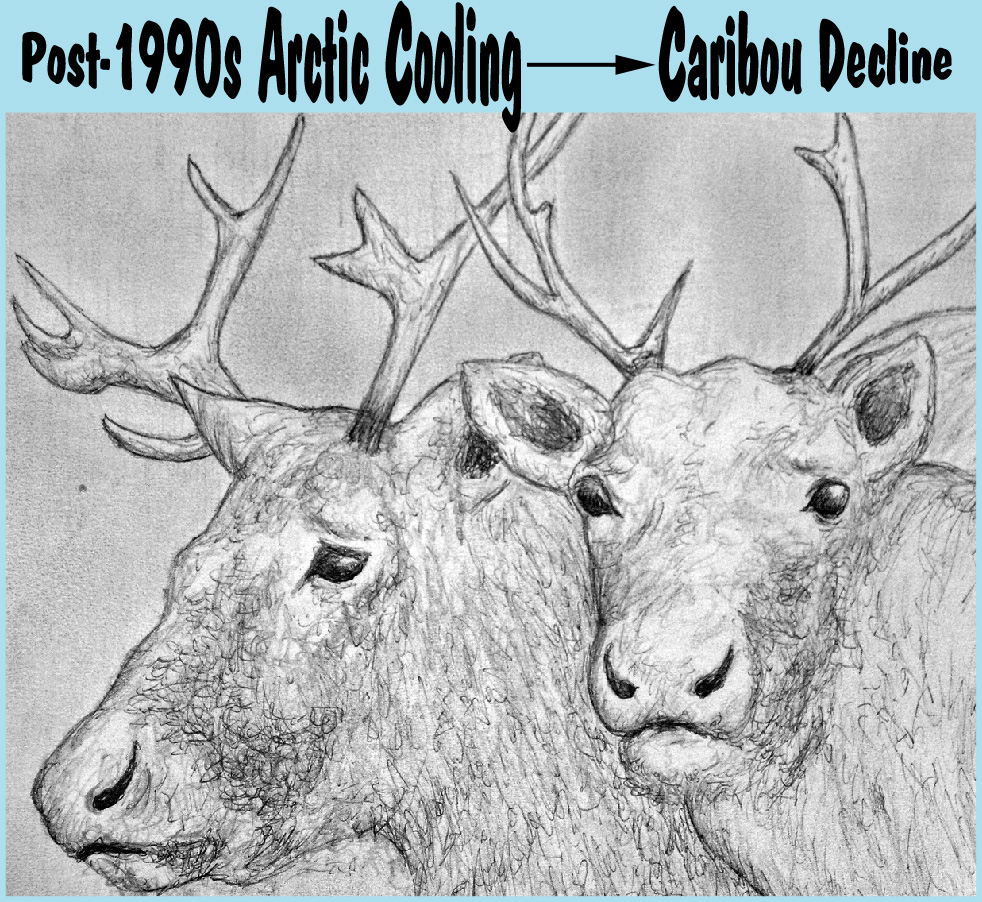
Contrary to the claims of anthropogenic global warming (AGW) advocates, the Arctic climate naturally warms and cools in a decadal-scale oscillatory fashion and in response to broad changes in the North Atlantic Oscillation and Arctic Oscillation. The climate does not just warm in a long-term linear pattern that follows the trends of anthropogenic CO2 emissions.
Naturally Driven (AO, NAO) Arctic Warming And Cooling
Ding et al., 2014 Here we show that the recent warming in this region [northeastern Canada and Greenland] is strongly associated with a negative trend in the North Atlantic Oscillation, which is a response to anomalous Rossby wave-train activity [planetary waves related to the Earth’s rotation] originating in the tropical Pacific. … This suggests that a substantial portion of recent warming in the northeastern Canada and Greenland sector of the Arctic arises from unforced natural variability.
Ohashi and Tanaka, 2010 Since the decadal variation of the AO is recognized as the natural variability of the global atmosphere, it is shown that both of decadal variabilities before and after 1989 in the Arctic [cooling, then warming] can be mostly explained by the natural variability of the AO [Arctic Oscillation] not by the external response due to the human activity.
To a significant degree, the natural decadal-scale undulations (warming-cooling-warming) in the Arctic’s temperature record could explain why there has been no net warming in the Arctic during the last 90 years. Long-term, there has also been no net warming in the Canadian Arctic since the 1860s, and today’s temperatures are 3°C colder than they were a few thousand years ago.
Fortin and Gajewski, 2016 Biological production decreased again at ~ 2 ka and the rate of cooling increased in the past 2 ka [2,000 years], with coolest temperatures occurring between 0.46 and 0.36 ka [460 and 360 years ago], coinciding with the Little Ice Age. Although biological production increased in the last 150 yr, the reconstructed temperatures do not indicate a warming during this time. Modern inferred temperatures based on both pollen and chironomids are up to 3°C cooler than those inferred for the mid-Holocene.
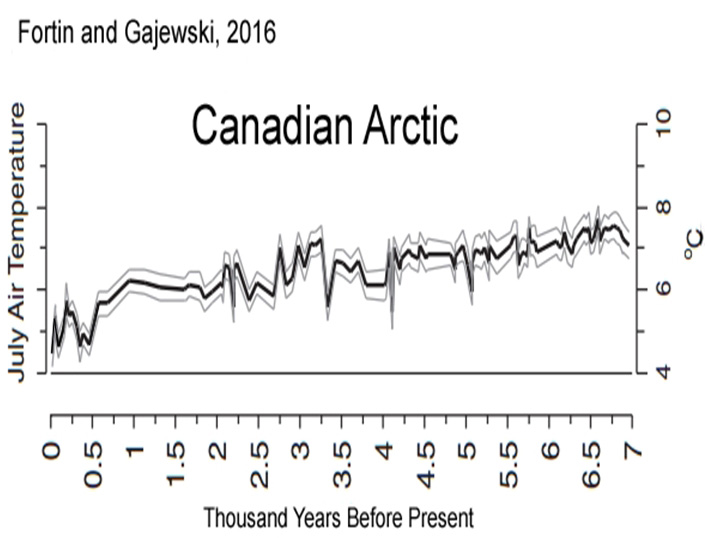
New Paper: Declining Caribou Numbers Linked To Arctic Cooling
In a new paper (Mallory et al., 2018), scientists have again concluded that the Arctic warms in response to a positive Arctic Oscillation (AO) and cools in response to a negative AO, precluding a deterministic role for anthropogenic CO2 emissions.
The authors point out that the Canadian Arctic has undergone an overall cooling trend since the late 1990s, or as the AO has pivoted from a positive (1988-1996, warming) to negative (1997-2016) stage.
Unfortunately, the recent (1990s-present) cooling trend has not been beneficial for the caribou populations native to this region.
Cooler temperatures mean less vegetation is available for foraging, and hence the body condition of the herds deteriorates and broad declines in population intensify. Alternatively, a warming Arctic climate means more food sources are available for caribou herds, leading to better body condition and greater fertility.
As Mallory and colleagues summarize, “population trajectories of caribou herds followed the direction of the AO: herds increased under positive AO intensity, and decreased under negative AO intensity.”
Mallory et al., 2018
Climate Influences Body Condition and
Synchrony of Barren-Ground Caribou
Abundance in Northern Canada
The AO [Arctic Oscillation] has positive and negative phases that influence broad weather patterns across the northern hemisphere (Thompson et al. 2000). For example, during the positive phase of the AO, atmospheric pressure over the Arctic is lower than average, which tends to result in warmer and wetter winters in northern regions as warmer air is able to move further north (Thompson et al. 2000; Aanes et al. 2002).
From 1988 to 1996, the summer intensity of the AO was largely in the positive phase [warming], with a mean value of 0.207 (± 0.135 SE), and this was a period of population stability or growth for each of the three herds that we examined here. In contrast, from 1997 to 2016 the summer AO has remained largely in the negative phase [cooling], with a mean value of − 0.154 (± 0.077 SE), and over this period the Bathurst, Beverly, and Qamanirjuaq herds declined in abundance.
Our results suggest that during periods of positive AO intensity, warmer temperatures on the summer range result in improved growing conditions for vascular plants that benefts foraging caribou. Conversely, negative summer AO intensity is associated with cooler temperatures with associated shorter growing seasons and increased precipitation on the Beverly summer range.
We found that positive intensities of the Arctic Oscillation (AO) in the summer were associated with warmer temperatures, improved growing conditions for vegetation, and better body condition of caribou. Over this same period, the body condition of female caribou was positively related to fecundity.
We further identified that population trajectories of caribou herds followed the direction of the AO: herds increased under positive AO intensity, and decreased under negative AO intensity.

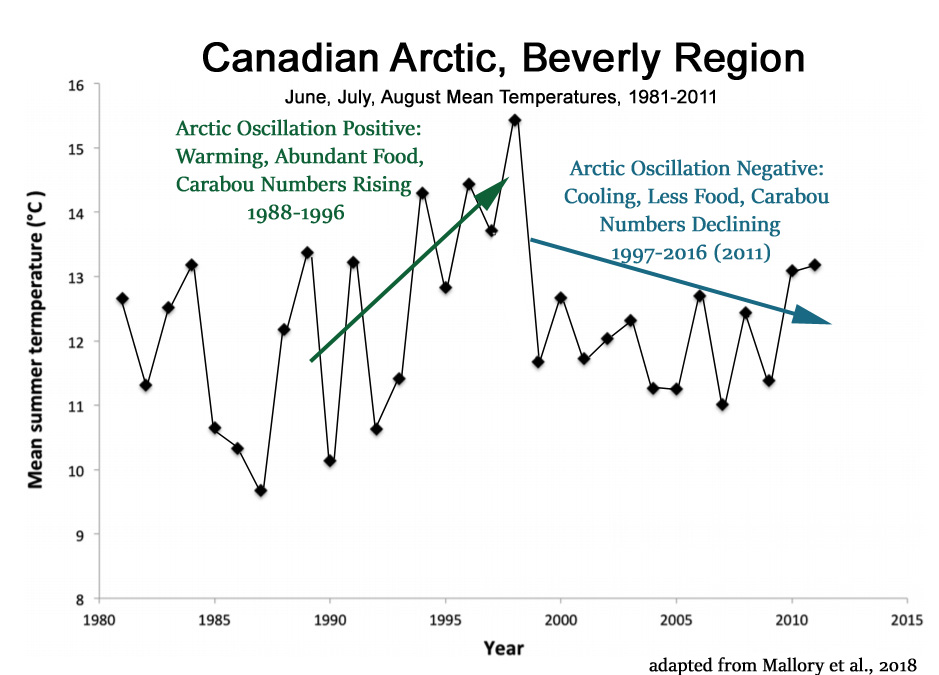
Copepod Species Also Thrive In A Warming Arctic
Caribou aren’t the only Arctic dwellers that benefit when the regional climate warms. According to yet another new paper, even copepod species native to the Arctic region thrive in a warming environment with less sea ice — and languish with cooling and more sea ice. Warmth promotes food availability and enhances growth and development transition success.
Feng et al., 2018
Biogeographic responses of the
copepod Calanus glacialis to a changing
Arctic marine environment
[E]nvironmental conditions in years with less ice cover were more favorable for C. glacialis development than those with more ice cover. The highest success rate (85.3%) occurred in 2012, coincident with the year of the lowest sea ice extent among the 35-year study period. Transition-zone annual mean temperature was negatively correlated with September-mean sea ice extent (r = −.92, p < .01), as was food availability (r = −.96, p < .01). [M]odeled C. glacialis habitats expanded during the past 35 years, as more and more C. glacialis individuals in the transition zone successfully developed to diapause over the modeled period. Before 1990, only 20%–30% of the transition-zone individuals succeeded while success rates were always >50% after 2000.
Annual mean temperature and food for the transition-zone individuals also showed significant upward trends although temperature appeared to have much higher variability than food. In the Chukchi Sea, significant increases in the biomass and abundance of zooplankton (particularly C. glacialis) were found in recent warm years as compared to the earlier cold years (Ershova et al., 2015). The strong positive correlation between mean developmental stage of C. glacialis and sea surface temperature from that study agreed with our modeling results, both suggesting that warmer temperatures sped up C. glacialis cohort developmental process.
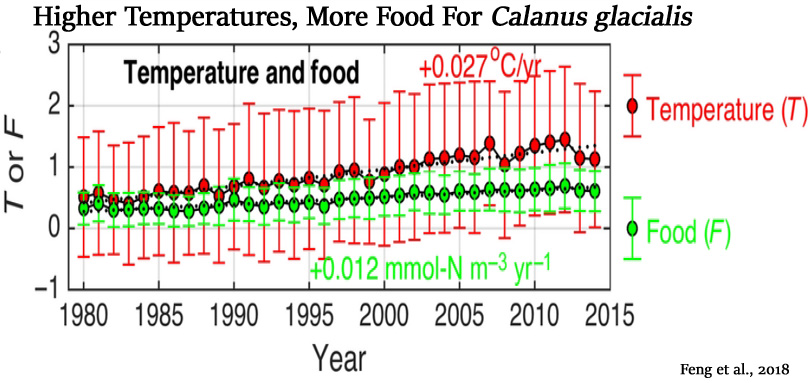
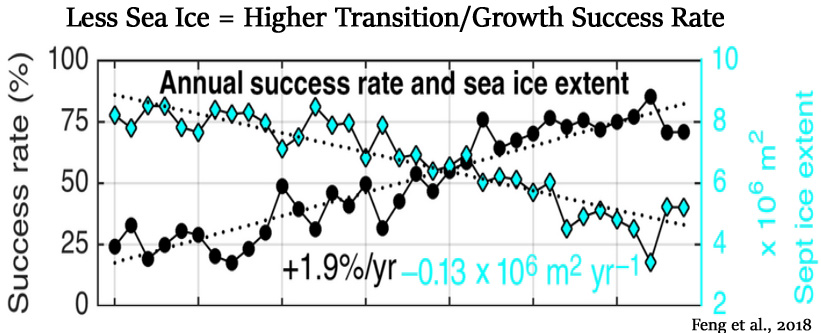





All good stuff but above my pay scale. Can I ask how much heat energy is radiated away from the Arctic when some 10,000 square kilometres of ice ice is absent from the sea? Also that ice, if present, would radiate much less energy at a temperature of say -25C.
I analysed CERES data over the Southern Ocean to compare the period following an El Nino year with an average year. If you recall there were reports that Antarctic sea ice was very low in early 2017. That was due to considerable heat coming down the western Pacific and warming the southern ocean surface. This chart shows the comparison of Feb 2014 with Feb 2017:
https://1drv.ms/b/s!Aq1iAj8Yo7jNgl6A_kPge4FvhyJh
On average there was 3W/sq.m more heat loss in 2017 than 2014 for the month over the entire Southern Ocean Fromm 55S to 85S, all longitudes; roughly 16% of the global ocean surface. Meaning an immense heat loss for the globe.
The CERES data clearly demonstrates the so-called iris effect that sea ice has. Removing ice to expose ocean surface is like opening a window to space. Less ice means more heat loss so sea ice loss is a negative feedback.
Antarctic is still struggling a bit, seems that El Nino released one heck of a lot of energy from the oceans world-wide.
Will be interesting to see what it does this coming expansion season.
One doesn’t need scientists to know this. Just ask those that live there. The Caribou Love the Alaskan pipeline during the cold.
I think I have mentioned , maybe a once or twice, that the recovery from the extreme levels of see ice of the late 1970s a (up there with the LIA) back some small way towards the more normal pre-LIA levels has been absolutely beneficial, especially for man, with the opening up, even for a short time, of travel, fishing, commerce routes via the Arctic.
Cold supresses life. Warm generally helps it thrive.
Thank you Kenneth for providing more proof 😉
OT, A great graph from Roger on WUWT, showing the total ineffectiveness of the anti-carbon agenda (wrt CO2 anyway)
https://wattsupwiththat.files.wordpress.com/2018/01/global-fossil-fuel-consumption.jpg
A minor comment. Oh! Cold means the deer eat more, brilliant scientist. Oh! Cold means immature crops at the end of a growing season? My God, did someone get past kindergarden? But finally, someone puts together the global story, halfway. Now if they will publish the other side of the coin, like, thank God for global warming, longer growing seasons, more food production. Less energy needed to survive. More carbon in the air, promotes plant growth, meaning more food available for the plant eaters, which means better steaks for us carnivores.
[…] Continue Reading […]
[…] Continue Reading […]